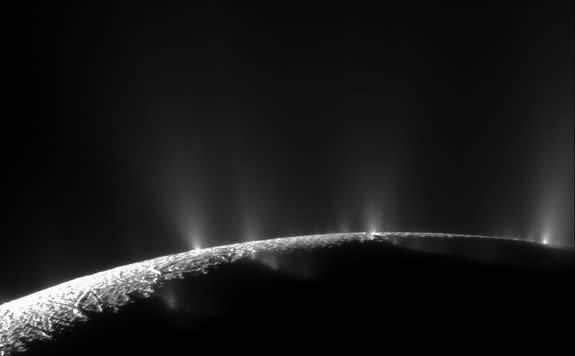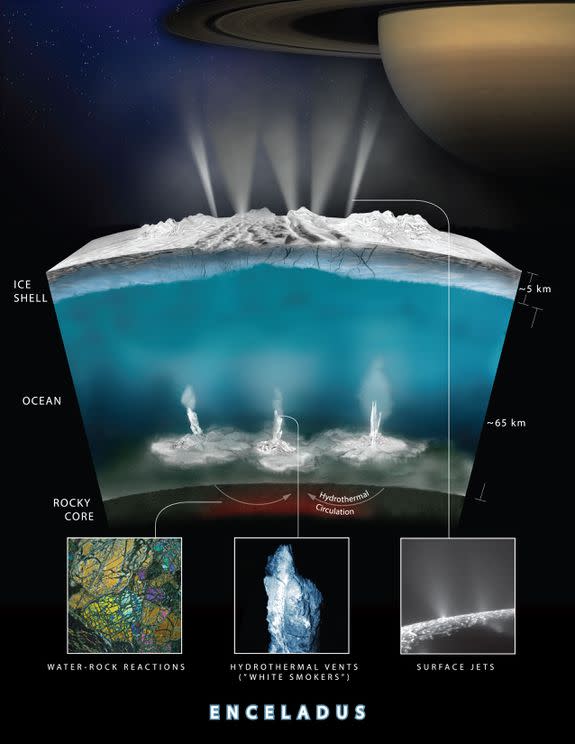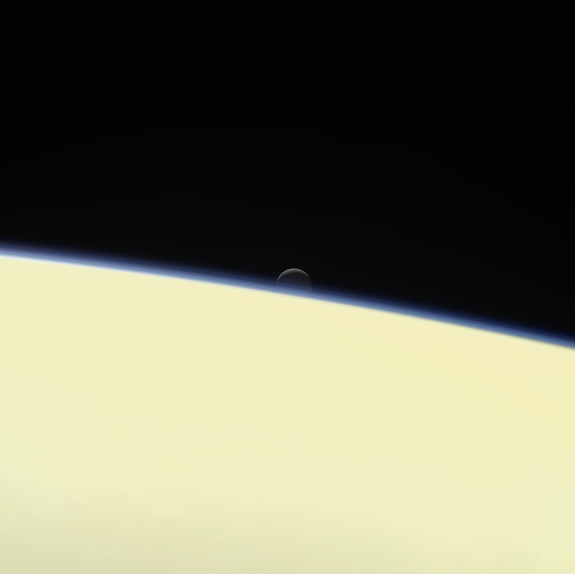Saturn's moon Enceladus may play host to hardy microbes like these

Something is happening beneath the ice on Saturn's moon Enceladus.
Scientists have long-thought that the icy world could possibly play host to microbial life within the subsurface ocean, which is hidden under a shell of ice. Now, thanks to some new Earthly research published this week in the journal Nature Communications, researchers have a little more proof that microbes could potentially thrive in that ocean's briny water.
Before the Cassini spacecraft plunged to its death in 2017, it flew through plumes of ice, water vapor, and gases being ejected near Enceladus's south pole. The spacecraft found traces of methane gas in that material.
SEE ALSO: Finding alien life probably won't drive us into panic and chaos
While methane can be produced through normal geological processes, it's also possible that microbes called methanogens could create that gas biologically.
On Earth, methanogens can survive in a wide range of harsh temperatures — more than any other known life. But the real question is: Could methanogens that we know of on Earth survive the moon's harsh conditions, and what could that tell us about Enceladus?
"Only they [methanogens] can cover the whole temperature range in which water is almost frozen to almost boiling," Simon Rittmann, who studies ancient bacteria (or archaebacteria) at the University of Vienna, said in an interview. "No other microbial group is known to be able to do this today."

Image: nasa
In the study, Rittmann and his team exposed three species of these methane-producing microbes — one of which (M. okinawensis) came from a deep-sea vent in the Pacific Ocean that thrives at around 140 degrees Fahrenheit — to a variety of pressures, temperatures, and levels of acidity that are thought to exist on Enceladus.
The idea was to expose Earth's methanogens to a wide array of environmental conditions, because it's unknown what exactly lurks beneath Enceladus' ice — and what conditions might exist there.
In their laboratory, M. okinawensis survived all the Enceladus-like test conditions, even in the presence of hostile compounds like formaldehyde and carbon monoxide — both of which are thought to exist on Saturn's moon.
Critically, Rittmann's team tested the microbes in oxygen-free conditions, as there's no evidence oxygen exists inside Enceladus. Instead, any life there must get their nutrients from non-living, or abiotic means — like hydrogen coming out of a volcanic vent.
"This is specifically important because on Enceladus you can’t assume that there's a lot of photosynthesis going on," said Rittmann.

Image: nasa
On Earth, methanogens living around deep-sea vents "eat" things like hydrogen and carbon-dioxide to survive — because there's little else that can persist under such heavy pressure, darkness, and cold. The product, or output from consuming these compounds, is methane. According to the study, similar microbes might do the same in the sea sloshing beneath Enceladus' ice shell.
"I think there is definitely potential there for methanogens," said Jennifer Glass, who studies astrobiology at the Georgia Institute of Technology, in an interview.
"We don’t know exactly what type [of methanogen] — but there could be life that makes methane present inside Enceladus," Glass, who was not involved in the new study, said.
Glass says that Enceladus' ocean could be quite similar to Earth's, except that it probably has a higher pH level, meaning it's less acidic.
Herein lies a limitation of Rittmann's study: The researchers didn't run experiments with a species of methanogen that can survive "at a really high pH" — and such conditions might exist in Enceladus' sea.
Still, Glass found the environmental conditions that the researchers studied to be scientifically solid. "The data quality and number of experiments are enormous and impressive," she said of the new work.
But although methane gas is shooting out of plumes on Enceladus, it certainly doesn't mean that it's coming from microbes.
"The question in the first place is, does the methane have to be biological?" she asked.

Image: nasa/jpl
The answer is no. The gas could come from geologic processes deep inside the moon.
On the other hand, microbes on Earth have been feeding off of hydrogen and carbon dioxide for millennia — so they could very well do the same on another world.
"This can come out of vents or volcanoes," Glass said. "So, it's a good model for other planetary bodies where we think there could be life."
Finding out if Enceladus' methane comes from microbes or geology, however, will be difficult.
"It's very challenging to sort out a biosignature to definitively prove that the methane is biological," Glass said.
To do it, Rittmann said another probe would likely have to be sent to Enceladus, some 750 million miles away, to get a more detailed picture of the methane being ejected from Enceladus.
But Rittmann said it's probably smarter to fly through the plumes, rather than actually landing on the moon and contaminating Enceladus with our own microbes.
"If we land there we might ruin the whole experiment," he said.
Update: This article has been updated to clarify what experiments the researchers performed in the study.
WATCH: Here’s how NASA is preparing the largest telescope ever built for space
